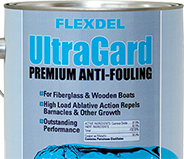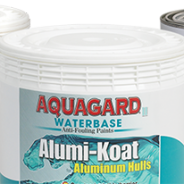Undeniable Benefits of Aquagard
Enviro-Friendly Multi-Season Ablative Water based paint produces better flow and rolling ability Soap and water clean up May be used over other ablative or “hard” bottom paints Exceeds Federal and State VOC standards Non-toxic fumes Controlled leach out United States EPA approved No Haz Mat extra shipping costs via UPS Allows for year-round indoor application Do not have to launch boat for 18 months once painted When boat is removed from water, paint will de-activate during storage and re-activate when replaced in water Can lower insurance rates Reduces the risk of toxic solvent exposure to the user Can be sprayed Proven performance in the marketplace Aquagard will not streak from rainwater (unlike solvent based paint) during storage Ultra-competitive pricing Flexdel Corporation’s Aquagard products are considered “environmentally preferable” because they release low levels of volatile organic compounds (VOC’s) and heavy metals compared to other competing products. Flexdel Corporation has commercialized many products, including Aquagard, which are patented, trademarked, UL approved, and registered with the US EPA. The Flexabar Group, is located in New Jersey and has entered their fifth decade of operation. The company was founded in 1953. Flexdel’s Aquagard brand has been successfully sold into the marine industry since...
read morePainting Instructions for Bare Aluminum
Bare Aluminum: Clean the hull surface thoroughly with de‐waxing solvent and plenty of clean rags. Sand the de‐waxed hull lightly with 80‐grit paper. Wipe down the area again to remove all sanding residue. Now apply 190 Primer. Follow the manufactures recommendations for primer application. You are now ready to apply bottom paint. Paint Mixing: The antifouling in bottom paint is often heavy and will settle to the bottom of your can. Make sure you take the time and effort to mix your paint properly. If you have a paint shaker, run it for at least 5 minutes to get the pigment evenly distributed throughout the paint. If you are Doing it by hand keep dredging up the sediment off the bottom of the can. Each time you add to your roller tray you will want to stir again to ensure consistency. Application: Roll the paint onto the hull using a short‐nap roller cover. Wear sleeves and gloves to keep the paint off your skin. Don’t add any thinner to bottom paint unless the manufacturer specifies otherwise. Fill your paint tray with paint. Dip your roller and roll it up and down on the hull. Each time you refill the paint tray, first stir the paint in the can to keep the pigment in suspension. By the time you work all the way around the hull, many bottom paints will be dry enough to overcoat. Check the specifications on the paint. A second coat is usually recommended and will increase the life of almost any bottom paint; copolymers benefit from 3 or 4 coats. No sanding or other prep is needed between coats. Once the paint dries to the manufactures specifications, you are ready to...
read moreAnti‐fouling bottom paints compatibility chart
Flexdel anti‐fouling bottom paints are designed to be as effective covering over existing bottom paints as they are protecting a bare hull. Knowing the compatibility of your existing anti‐fouling paint and proper hull preparation are key factors in ensuring the longevity and effectiveness of your paint. This graph will help you determine your existing paints...
read moreFlexabar Buoy Paint Application Instructions
Apply by brush or roller for best results. Do not use felt type rollers, recommend foam rubber roller. Best days for application are days with low humidity and temperatures above 40°F. DIRECTIONS FOR USE: Surface must be completely dry and clean. Buoy Coating Thinner is recommended for cleaning. Stir Buoy Coating thoroughly from bottom of can until pigment is evenly distributed. Can be applied without thinning. If thinning is necessary, mix up to one part Buoy Coating Thinner to two parts Buoy Coating. Before using brush or roller, wash thoroughly with Buoy Coating Thinner. Brush small areas at a time. Buoy Coating dries to the touch within 30 minutes, cures overnight. First coat should be dry to touch before applying second coat. Two coats should be adequate for normal use but additional coats may be applied. Clean brush or roller thoroughly with Buoy Coating Thinner after...
read moreBottom Paint Steps for Application
Maintaining your boat’s painted surfaces and periodically repainting the boat is important for more than just your boat’s appearance. Marine paints and finishes help protect your boat’s hull, deck, and other surfaces from the harsh effects of the sun, the corrosive effects of salt water, and algae and barnacle growth. Here are some step by step instructions to help you get the best results when painting the bottom of your boat. Preparing your boat for a bottom paint job doesn’t have to be difficult — but knowing what to do, and in what order, is essential. Prep: The best time to clean and prepare the bottom of your boat is when you haul it out at the end of the season. Once you let the slime and growth dry and harden it is much more difficult to remove. The easiest method is to have your boat yard pressure wash the bottom as soon as they haul the boat. If your old bottom paint starts flaking off, you should get a scraper and remove all loose flakes. You might want to consider using a paint stripper and removing the old layer completely if the paint is in poor condition. When to Strip Old Paint: Remember that the adhesion of the new paint is only as good as paint that it is being applied over. So watch for signs of adhesion failure. Anywhere the old paint is flaking or lifting, the bottom needs to be stripped. You may also have to strip the bottom if you are changing the type of paint. For example, the aggressive solvents in vinyl paints lift other types of bottom paints, so if you are applying vinyl, any non-vinyl paint has to come off. And soft, sloughing paints are a poor undercoat for anything other than a fresh coat of the same. Sanding: If your bottom paint is in good condition you really only need to sand it a little with 80-grit sandpaper (you can use a finish sander or a random orbital sander), clean it up, tape it off and roll on another coat. Safety: Antifouling dust can be a major health hazard and you really should be wearing a respirator and particulate filter as well as eye and ear protection for your own safety. Bare Fiberglass: A hull that has not been previously painted has mold release wax on the fiberglass. That will interfere with paint adhesion unless you remove it. Clean the hull surface thoroughly with dewaxing solvent and plenty of clean rags. Sand the de-waxed hull lightly with 80-grit paper. Wipe down the area again to remove all sanding residue. Now apply a primer. Follow the manufactures recommendations for primer application. You are now ready to apply bottom paint. Paint Mixing: The antifouling in bottom paint is often heavy and will settle to the bottom of your can. Make sure you take the time and effort to mix your paint properly. If the copper isn’t evenly distributed, some areas of your hull will not be protected. If you have a paint shaker, run it for at least 5 minutes to get the copper and the pigment evenly distributed throughout the paint. If you are doing it by hand keep dredging up the copper off the bottom of the can. Each time you...
read more

